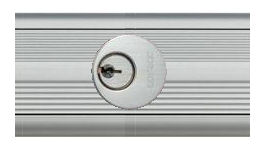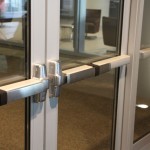On Tuesday, I posted an infographic about panic hardware that sparked a lot of good conversation – thank you to everyone who weighed in! The piece is in the process of being revised to incorporate some of your comments. There were several questions about the “dogging” feature on panic hardware, which holds the latch retracted. I was reminded of this guest blog post that I first published in 2011, written by TJ Gottwalt.
IT’S A DOG EAT DOG WORLD
By: T.J. Gottwalt, AHC, CDC, CSI, CCPR, MAI, Allegion
Ever wonder about some of the strange terminology we use for specific construction products, especially door hardware? Twisted, I know. Take, for example, the term “dogging”. Webster defines dogging as a transitive verb and as follows:
1. a. to hunt, track, or follow like a hound
….b. to worry as if by pursuit with dogs
….c. to bother or pester persistently
2. to fasten with a dog (Aha! Read on, friend…)
Dogging in Scotland refers to truancy. Wikipedia lists dogging as a British English euphemism (which we will not go into in this article), but also lists it as “the use of a mechanical device called a ‘dog’ to fasten something to something else (for example, doors, hatches, or shafts).” I think this is where we’re onto something, because the term dogging in the hardware world refers to the use of a mechanical device to hold a latch in a retracted position. Most commonly, dogging is a feature used in panic hardware to hold the push rail or bar in a retracted position, thus allowing a door to operate in push/pull mode without latching. Dogging can also be applied to aluminum door latchsets and other latching devices.
Most exit devices are “dogged down” by depressing the push rail and, using a common allen wrench inserted in a hole, turning a cam which holds the rail (and thus the latchbolt) in a retracted position. This dogging serves several functions. On a door with pull trim, this essentially locks or unlocks the door for daily use. It also serves to minimize the cycles the exit device push bar and latch are subject to, thereby extending the life of the hardware immeasurably. It also means the door operates much more quietly, a valid concern if you’re specifying hardware for a courtroom, an office, a theater, or a performing arts center.
If you’re thinking that relying on something as simple as an allen wrench (or hex key) to secure perimeter doors sounds a bit foolish, you’d be right. That’s why cylinder dogging is an oft used option on exit devices. This option requires that a key be used in a cylinder in order to “dog” the exit device (see Figure 2). Whenever I’m consulting on a school project, I’m sure to remind the architect about how school kids love to dog down the exit devices on exterior doors late on a Friday afternoon by using an allen key taken from their parents’ toolbox. (I have no personal experience with this, of course.) This basically leaves these doors unsecured for the entire weekend. Cylinder dogging can eliminate this potential security threat.
It is important to note that fire rated exit devices cannot be dogged mechanically. Since one of the requirements for fire doors is that they are self-latching, dogging fire exit hardware would not allow the door to latch. For that reason, fire rated exit devices have no manual means of dogging. However, there are electrical means of dogging an exit device so that, in case of a fire alarm, the device can automatically “undog” and allow the door to latch. That’s a topic for another exciting article…
So, it really is a dog-eat-dog world out there… just don’t be caught wearing milkbone underwear!
You need to login or register to bookmark/favorite this content.












Great article, Norm!
Despite being retired all these years, I find myself still looking at door hardware for a means of deranging it with a dogging device. about 6 times in my career, I found doggable panic hardware where fire rated hardware should have been installed. While touring a steam plant I found doggable panic hardware on a required fire rated opening and you guessed it, the fire rated hardware not doggable on an exterior door to the outside without the need for fire rated hardware, nothing of concern anywhere nearby. They swapped it and were unaware of how visual and easy this mistake is to find.
Hi Jerry –
I think there are MANY people who don’t understand the difference between panic hardware and fire exit hardware, and the importance of positive latching on fire door assemblies.
– Lori
T J
Good recovery!!! You have a hard audience out here. Remember they are Lori trained.
Keep up the great work!
“”Waggle it and let the big dog eat.“””
Yes, great article